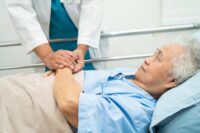Ever hear someone say, “His snoring is killing me”? The truth is, snoring can kill the snorer. It’s a symptom of sleep apnea, which strikes more than 12 million Americans. The vast majority of these sufferers don’t know they have the condition and thus go untreated, risking their health and even their lives.
Understanding the disorder
Sleep apnea is characterized by brief interruptions of breathing during sleep. Most people with the condition have periods of apnea lasting about 20 to 30 seconds, although they can last up to 3 minutes. Because the episode instigates wakefulness, the person doesn’t sleep deeply and is likely to experience excessive daytime sleepiness.
Sleep apnea can be obstructive or central.
- Obstructive sleep apnea (OSA), the more common type, results from upper airway occlusion by the tongue, tonsils, uvula, or soft tissue in the rear of the throat. The resulting apnea leads to progressive asphyxia, which causes the sleeper to awaken in an attempt to restore the airway. The person then falls back to sleep and the pattern is repeated—commonly, up to 500 times a night. This causes fragmented nighttime sleep and sleepiness during the day.
- Central sleep apnea occurs when the neural drive to the respiratory muscles is abolished for brief periods. In this type of apnea, the airway isn’t blocked; instead, the brain fails to signal the muscles to breathe. Signs and symptoms resemble those of OSA.
Associated problems
Untreated sleep apnea can be life-threatening in several ways. For one thing, it has cardiopulmonary implications: During apneic episodes, the cyclical heart rate may decrease as low as 30 to 50 beats/minute, followed by tachycardia of 90 to 120 beats/minute during the ventilatory phase. Severe bradycardia or tachyarrhythmias may result, possibly leading to sudden death.
Also, unlike healthy persons, OSA sufferers don’t experience a blood pressure decrease during sleep. Typically, their blood pressure rises abruptly at the end of each obstructive event, from sympathetic nervous system activation and reflex vasoconstriction.
OSA has been implicated as a risk factor in development of systemic hypertension, although the underlying reason isn’t known. It can also trigger myocardial ischemia in patients with coronary artery disease.
Assessing patients for sleep apnea
The hallmark of sleep apnea is excessive daytime sleepiness, which initially manifests during passive activities. For example, the sufferer may fall asleep while watching TV or reading. As the disorder progresses, sleepiness affects all aspects of daily life and can become disabling and dangerous. Several studies have implicated OSA in motor vehicle accidents.
Additional symptoms include loud snoring, restless sleep, morning headache, intellectual deterioration, personality changes, and behavioral disorders. In children and adolescents, untreated sleep apnea can lead to academic underachievement.
Risk factors
On admission, assess patients for the following risk factors:
• male gender
• overweight
• age older than 40 (but be aware that sleep apnea can occur at any age—even during childhood)
• large neck size (17″ or greater in men or 16″ or greater in women)
• family history of sleep apnea.
Diagnosis
The definitive investigation for suspected OSA is polysomnography (PSG), which takes place in a specially constructed sleep laboratory.
In patients with a high pretest probability of OSA, overnight oximetry can be done at home to confirm the diagnosis, eliminating the need for PSG.
Treatment options
Many patients can manage mild or moderate OSA by losing weight, avoiding alcohol and sleep medications, and sleeping on the side instead of the back. Some patients may use an oral dental appliance that pushes the mandible forward and prevents the tongue from falling backward and closing the airway.
Severe OSA may warrant surgery or nasal continuous positive airway pressure (CPAP) during sleep. Uvulopalatopharyngoplasty increases the pharyngeal lumen by resecting redundant soft tissue. Nasal CPAP prevents upper airway occlusion by splinting the pharyngeal airway with positive pressure delivered by a nose mask. This is the most common and successful long-term treatment approach.
Making sleep safer for patients
Don’t let a patient’s snoring go unexamined. If your patient is at risk for sleep apnea or has already been diagnosed with it, stay alert for apneic episodes during hospitalization. If these occur, urge the physician to order sleep studies.
In patients with known sleep apnea who use CPAP at home, ask what the settings are and obtain an order for this machine in the hospital, as needed. Refer patients to the American Sleep Apnea Association (www.sleepapnea.org) to learn more about the disorder.
References
Barnes M, McEvoy R, et al. Efficacy of positive airway pressure and oral appliance in mild to moderate obstructive sleep apnea. Am J Respir Crit Care Med. 2004;170(6):656-664.
Kushida C, Morgenthaler T, Littner M, et al. Practice parameters for the treatment of snoring and obstructive sleep apnea with oral appliances: an update for 2005. Sleep. 2006;29(2):240-243.
Pagana K, Pagana T. Mosby’s Diagnostic and Laboratory Test Reference. 8th ed. St. Louis, Mo: Mosby/Elsevier Publishing; 2007.
Kathleen D. Pagana, PhD, RN, is a keynote speaker, Professor Emeritus at Lycoming College in Williamsport, Pa., and President of Pagana Seminars & Presentations. She is the coauthor of 18 books on diagnostic and laboratory testing, including Mosby’s Diagnostic and Laboratory Test Reference and Mosby’s Manual of Diagnostic and Laboratory Tests. Her website is www.kathleenpagana.com.


















